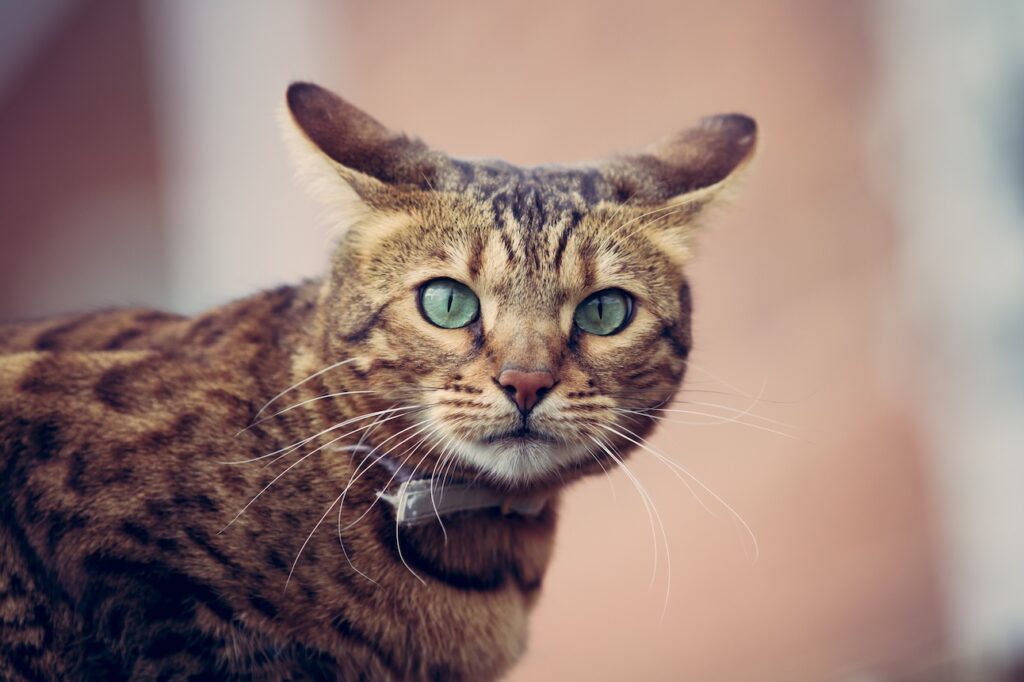Cat Airplane Ears: What They Mean, and What To Do

Photo by Teamjackson/iStock/Getty Images Plus
Cats have amazing ears that can detect sounds far beyond human or even canine hearing. They can swivel their ears 180 degrees and move them independently of each other. This makes cat ears not just useful for hunting, but also an expressive communication tool.
If you’ve ever noticed your cat’s ears shift from perked up to flattened out and angled sideways like a “T,” that’s cat airplane ears—and your cat’s subtle way of expressing discomfort.
Key Takeaways
- Cat airplane ears occur when a cat flattens and angles their ears sideways, resembling airplane wings.
- This ear position is your cat’s way of telling you they’re uncomfortable.
- When you see airplane ears, pause interactions with your cat and try to identify the trigger.
- Persistent airplane ears, especially when accompanied by other behavioral changes, warrant a trip to the vet.
What Are Cat Airplane Ears?
“Airplane ears” refers to a cat’s ears when they rotate backward and flatten sideways, giving your feline friend a look not unlike the swept-back wings of a jet. You can also picture them forming a “T,” with the center of the head forming the vertical line and the two ears flattened and pointing straight out to the sides.
This incredible control over ear position is thanks to cats’ unique ear anatomy.
Humans have only six muscles that move the outer ear (the pinna), which allows some people to wiggle their ears. Cats, on the other hand, have 32 muscles in their outer ear, giving them the ability to swivel, rotate, and move each ear independently of the other.
Airplane ears are just one of the many ear positions cats use to communicate.
What Do Airplane Ears Mean on a Cat?
When you catch your cat’s ears in “take-off mode,” here’s what they might be trying to tell you:
Your Cat Is Overstimulated
According to Samantha Bell, a Los Angeles-based cat expert for Best Friends Animal Society, a comfortable cat has a neutral posture: ears upright, eyes soft, and body relaxed. Add an upright tail, and you’ve got a cat who’s not just content, but who’s happily engaged.
When a cat becomes overstimulated, it means too much is going on, and they want it to stop. “It could be too much petting, music that’s too loud—anything overwhelming,” Bell explains.
Cats often use subtle body language to communicate their discomfort, and ear positioning is often one of the first. If their ears start to swivel outward into airplane ears or flatten, that’s your cue to pause.
If we miss these signals, even a friendly cat may bite or scratch to end the interaction, a behavior experts call petting-induced aggression.
Your Cat Is Stressed, Nervous, or Afraid
Cats who are frightened often try to make themselves appear smaller, says Marc Smith, DVM, MS, veterinarian and owner of Natchez Trace Veterinary Services in Nashville.
Flattening their ears into “airplane ears” helps them do this, along with crouching, tucking their tail, and moving away from whatever they perceive as a threat.
Your Cat Is in Pain
It’s not always easy to tell when a cat is in pain, but Kat Pankratz, DVM, DACVB, veterinary behaviorist at the Animal Behavior Clinic in Portland, Oregon, says subtle changes in ear or head position can be early indicators.
Acute pain may cause quick, subtle ear changes, while a cat experiencing significant or prolonged discomfort is more likely to display consistent airplane ears, she says.
However, ear position alone isn’t enough to confirm pain, since fear or overstimulation can look similar.
“It’s important to look at the whole face,” Dr. Pankratz says. Painful cats often have tight, squinting eyes, tense facial muscles, and a lowered or tucked head posture.
How To Respond to a Cat’s Airplane Ears

Photo by rai/iStock/Getty Images Plus
Airplane ears are your cat’s way of saying they’re uncomfortable. So when you notice them, stop what you’re doing and give your cat some space.
Then, look around for what might be bothering them—like loud sounds, unwanted handling, other pets, or unfamiliar visitors. Figuring out the source of discomfort often requires observing the situation and paying close attention to what else your cat is communicating through their body language.
Once you’ve identified the trigger, you can take action by either removing it or providing your cat with a safe retreat, such as a quiet room or a covered bed where your cat can relax until things calm down.
Recommended Products
If airplane ears appear during play or petting, pause the interaction and let your cat walk away freely.
When To See the Vet
While airplane ears most often indicate environmental or emotional stress, they can also signal pain or illness.
If your cat is displaying other behavioral changes (like hiding, lack of appetite, vocalizing differently, or changes in grooming), schedule a checkup with your veterinarian to rule out medical causes.





